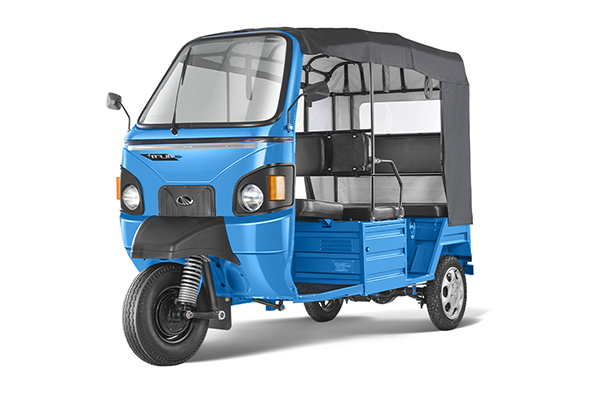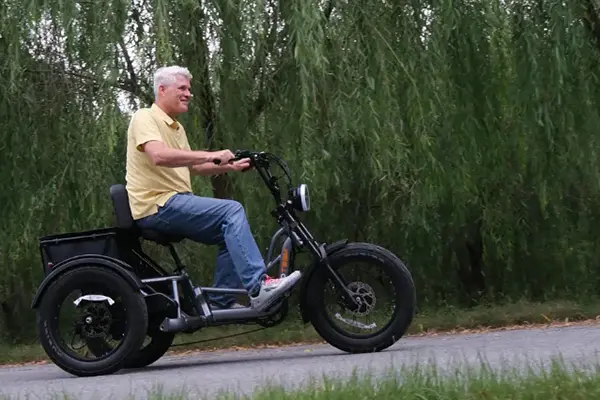Hello, I’m Allen. For over a decade, my factory has been at the forefront of manufacturing high-quality electric tricycles for clients all over the world, from North America to Europe and Australia. I’ve had countless conversations with business owners like Mark Thompson from the USA, who are looking to build efficient delivery fleets or passenger transport services. One question comes up more than any other, and it’s a crucial one: "Where, exactly, are my staff allowed to ride these vehicles?" The confusion often centers on one specific place: the sidewalk.
This article is for you. Whether you’re a fleet manager, a small business owner, or an individual rider, understanding the rules of the road is vital for safety, compliance, and peace of mind. We will dive deep into the laws and etiquette surrounding riding an electric bike or tricycle on the sidewalk. We’ll clarify the gray areas, highlight the dangers, and give you the tools to make the safest choice every time you ride.
Why is Riding on the Sidewalk Such a Big Question for Electric Tricycle Users?
The question of whether you can ride on the sidewalk isn’t born from a desire to break rules. From my experience talking to customers, it comes from a genuine concern for safety. Riders often feel vulnerable sharing a road with cars and trucks, especially in cities without a dedicated bike lane. The sidewalk can feel like a safe haven, a space away from fast-moving traffic. This is particularly true for those new to riding an electric vehicle or for those operating a slightly larger vehicle like a trike.
However, this perception of safety is one-sided. While the rider might feel safer, a powered vehicle on a sidewalk introduces a new set of risks for the most vulnerable road users: pedestrians. The core of the issue is the conflict between different modes of transport sharing a space not designed for it. An electric tricycle, while stable and easy to ride, is heavier and faster than a walking pedestrian. This mismatch is why so many regulations exist and why the question remains so persistent.

What’s the General Rule for E-Bikes and Sidewalks in the U.S.?
To understand the rules for an electric trike, we first have to look at the regulations for its two-wheeled cousin, the electric bike. In the U.S., many states have adopted a three-class system to categorize e-bikes, which helps designate where they can be ridden.
- Class 1: The motor provides assistance only when the rider is pedaling and cuts off at 20 mph.
- Class 2: Has a throttle that can power the bike without pedaling, but the motor also cuts off at 20 mph.
- Class 3: The motor assists up to 28 mph and usually requires the rider to pedal (though some may have throttles).
Now, here’s the critical part: Even with these classifications, there is no federal law that permits riding an e-bike on the sidewalk. The opposite is generally true. Most states and cities explicitly ban e-bikes from the sidewalk to protect pedestrians. They treat an electric bike much like a traditional bicycle or moped—it belongs on the street or in a dedicated bike lane. The simple logic is that a space designed for walking cannot safely accommodate a powered vehicle, no matter how quiet its electric motor is.
How Do Electric Tricycles Fit into These Bike Laws?
This is where it gets a bit murky, and why I get so many questions. Most laws are written with a two-wheeled bike in mind. An electric tricycle occupies a unique space. Is it a bike? A mobility device? Something else entirely?
In the eyes of the law, most jurisdictions treat a three-wheeled electric tricycle the same as a two-wheeled e-bike. If you can’t ride an ebike on the sidewalk, you almost certainly can’t ride an electric trike there either. The same principles of pedestrian safety apply, perhaps even more so. A trike is wider than a standard bike, taking up more of the sidewalk and making it harder for people to pass.
"As a manufacturer, we design our vehicles for specific environments. Our cargo and passenger etrikes are built for the road and dedicated bike paths. We advise all our clients to operate them as they would any other light vehicle: with awareness and in the proper lane." – Allen, Factory Owner
The key takeaway is to assume your electric tricycle is not permitted on the sidewalk unless you find a specific local ordinance that states otherwise. The burden of proof is on the rider to know the rules.
Are There Any Situations Where You Can Ride an Electric Tricycle on the Sidewalk?
While the general rule is a firm "no," there are a few rare exceptions. It’s important to understand these aren’t loopholes but specific allowances made under certain conditions.
- Mobility Devices: If an electric trike is medically necessary and classified as a mobility aid (like a power scooter), it may be permitted on the sidewalk. However, these devices are typically speed-limited and have different legal classifications. Our standard passenger and cargo models are not considered mobility devices.
- Local Ordinances: Some small towns or suburban communities with very low pedestrian traffic and wide sidewalks might have local laws that allow electric bike or trike use on the sidewalk. This is extremely rare and will be explicitly stated in the town’s vehicle code. You must check with your local government.
- Connecting to a Path or Lane: In some areas, you may be permitted to briefly ride on the sidewalk for a short distance to access a bike lane, trail, or street. This is usually a matter of common sense, but you should still yield to every single pedestrian.
- Private Property: Rules for public sidewalks don’t apply to private property. Large industrial campuses, resorts, or private communities can set their own rules for where you can ride your electric vehicles.
It’s clear that the exceptions are few and far between. For 99% of riders, the sidewalk is off-limits.

What are the Dangers of Riding an Electric Bike or Tricycle on the Sidewalk?
The primary reason to avoid the sidewalk is safety—for everyone. When a client like Mark asks me about this, I always emphasize the liability and risk involved, which goes far beyond a simple ticket.
- Speed Disparity: The average person walks at about 3 mph. Even a slow-moving electric bike travels at 10-15 mph. This difference in speed doesn’t give a pedestrian enough time to react.
- The Element of Surprise: Electric motors are nearly silent. A pedestrian won’t hear you coming. Imagine someone stepping out of a doorway, a child chasing a ball, or a person with a visual impairment. The risk of a serious accident is incredibly high.
- Obstacles and Limited Space: Sidewalks are not smooth, clear paths. They have cracks, curb cuts, utility poles, benches, and people. Navigating these on a bike is difficult; on a wider tricycle, it’s nearly impossible without creating a hazard.
- Legal Liability: If an accident occurs while you are illegally riding on the sidewalk, you or your company will almost certainly be found at fault. The financial and legal ramifications can be devastating for a business.
The bottom line is that the sidewalk is a dedicated space for pedestrians. Bringing a powered cycle into that environment creates an unacceptable level of risk.
Where Should You Ride Your Electric Tricycle for the Safest Experience?
So, if the sidewalk is out, where should you ride? The good news is that cities are increasingly building infrastructure to support vehicles like e-bikes and e-trikes. As a rider or business owner, your goal is to use these systems as they were intended.
The Hierarchy of Safety for Riding:
- Protected Bike Lane: This is the gold standard. A protected bike lane is a path physically separated from both car traffic and the sidewalk. This is the safest possible place to ride.
- Standard Bike Lane: A painted lane on the road is the next best thing. It signals to drivers that they should expect to see a cyclist or e-bike rider and provides a designated space for you to ride.
- The Street (with Traffic): In the absence of a bike lane, your place is on the road. It’s crucial to ride defensively.
- Be Visible: Use lights, even during the day, and wear bright clothing.
- Be Predictable: Ride in a straight line, use hand signals, and make eye contact with drivers.
- Claim Your Lane: Don’t hug the curb too tightly. This can encourage drivers to squeeze past you unsafely. Riding a bit further into the lane makes you more visible and forces cars to change lanes to pass you properly.
We design our products, like the popular EV5 Electric passenger tricycle, with road safety in mind. They feature bright LED headlights, turn signals, and robust braking systems to ensure they perform reliably in traffic. The goal is to integrate safely with other vehicles, not to retreat to the sidewalk.
How Do I Check the Specific Rules for My City or State?
The single most important piece of advice I can give is this: laws in place vary from city to city. Rules in Chicago are different from those in rural Texas. Before you or your employees ride, you must do your homework.
A Simple Checklist to Find Local Laws:
- Start with a Google Search: Use phrases like "e-bike laws [Your City Name]" or "are electric bikes allowed on sidewalks in [Your State]".
- Check Your Local City or Municipal Website: Most cities have their vehicle codes or transportation rules published online. Look for the transportation department or public works section.
- Contact the Department of Motor Vehicles (DMV): Your state’s DMV is an excellent resource for vehicle regulations.
- Call the Non-Emergency Line for Your Local Police Department: The local police are responsible for enforcing traffic laws and can provide the most accurate, on-the-ground information about your specific e-trike policy.
Don’t rely on what someone told you or what you think the rule is. As a business owner, you need certainty. A few phone calls or a bit of online research can save you from fines, liability, and potential business disruption. You must check your local city regulations.
As a Business Owner, What Do I Need to Know About Sidewalk Laws?
For a business owner like Mark, this issue goes beyond a personal choice; it’s about risk management, employee safety, and brand reputation. When deploying a fleet of electric vehicles, whether for logistics or passenger service, you have a responsibility to operate legally and safely.
First, training is non-negotiable. Your employees must be explicitly trained on local traffic laws, including the prohibition of riding e-bikes on the sidewalk. This training should be documented. This protects your employees and your business. The local government often has resources for this.
Second, consider the vehicle itself. For last-mile delivery, you need a vehicle that is efficient but also compliant. A robust vehicle like our Van-type refrigerated electric tricycle HPX20 is designed for the street. Its enclosed cabin and professional appearance signal that it’s a commercial vehicle, not a recreational toy to be used on a sidewalk. This helps manage public perception and reinforces professional conduct.
Finally, lead by example. Create a company culture that prioritizes safety over shortcuts. The few seconds saved by illegally using the sidewalk are not worth the potential for a tragic accident or a lawsuit. A clear and enforced e-trike policy is a must.
What Features Should I Look for in a Compliant and Safe Electric Trike?
When you’re sourcing vehicles, you’re not just buying a piece of equipment; you’re investing in a tool for your business. Reliability and safety are paramount.
Here’s a table of features I always discuss with my clients:
| Feature | Why It Matters for Safety and Compliance |
|---|---|
| Robust Braking System | Essential for controlling speed and making emergency stops in traffic. Disc brakes are often superior. |
| High-Visibility Lighting | A bright headlight, taillight, and turn signals are critical for being seen on the road, day or night. |
| Durable Frame Construction | A well-built frame ensures stability and durability, especially when carrying cargo. |
| Speed Limiter Options | Some models can be electronically limited to certain speeds to comply with local city level regulations for e-bikes. |
| Stable Handling | A low center of gravity and quality suspension make the ride smoother and safer, especially on imperfect roads. |
When evaluating an electric tricycle, think about how it will perform in its intended environment—the street. For example, our best-selling Electric cargo tricycle HJ20 is a workhorse designed specifically for the demands of commercial use, with a heavy-duty frame and powerful motor meant for the road, not the sidewalk. We even offer a 30-day test ride for bulk orders so fleet managers can see the quality for themselves.
What’s the Future of Electric Ride Regulations?
The world of micromobility is evolving rapidly. As more people and businesses adopt electric vehicles to get around, cities are responding. The future is not about finding ways to ride on the sidewalk; it’s about creating better infrastructure for everyone.
We are seeing a positive trend toward:
- Expansion of Bike Lane Networks: Cities are realizing that providing safe, separated infrastructure is the best way to encourage the use of e-bikes and e-trikes.
- Clearer Legislation: As these vehicles become more common, laws are catching up. We expect to see more precise regulations that specifically address electric tricycles, removing the current ambiguity.
- Education and Awareness Programs: More cities are launching campaigns to educate drivers, cyclists, and pedestrians on how to share the road safely.
The goal for all of us—manufacturers, business owners, and riders—should be to advocate for and properly use this new infrastructure. The more we demonstrate that we can ride responsibly on the streets and in bike lanes, the more public and political support we will gain. Enjoy the ride, but do it in the right place.
Key Takeaways to Remember
To wrap things up, here are the most important points to remember about where to ride your electric vehicle:
- Assume the Sidewalk is Off-Limits: The default and safest assumption is that you cannot ride an electric bike or tricycle on a public sidewalk.
- Local Laws are King: Rules change drastically from one place to another. Always check your local city‘s regulations before you ride.
- Safety First, Always: Riding on the sidewalk poses a significant danger to pedestrians. The safest place for a powered vehicle is in a protected bike lane or on the street.
- Choose the Right Vehicle: Invest in a high-quality electric vehicle with safety features designed for road use. As a premier Electric Cargo Tricycle, Electric Passenger Tricycle Supplier, we can help you find the perfect model for your needs.
- For Businesses, Training is Essential: Ensure your employees are fully trained on safe and legal riding practices to protect them and your company from liability.
Post time: 07-10-2025




